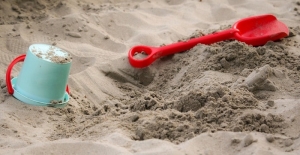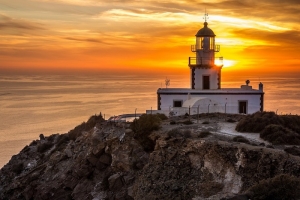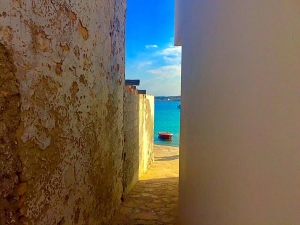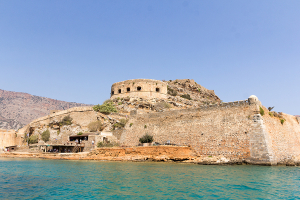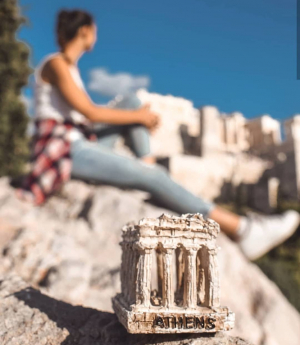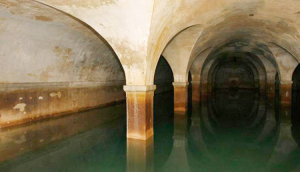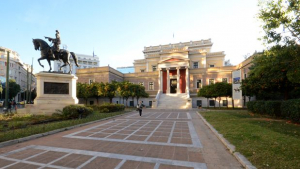XpatAthens
Thursday, 10 November 2016 07:00
5 Reasons Greece Is The Perfect Destination For Families
From excellent weather and great family hotels, Greece offers a lot for a family holiday. Chrissy from Travel Passionate shares her reasons why Greece is the perfect family destination all year round, along with family-friendly destinations!
The Food
The Mediterranean cuisine of Greece with its fresh vegetables, fruits, and olive oil are perfect for a healthy meal. Also, in most tavernas and restaurants in Greece, you will find delicious homemade food ideal for children. The tavernas and restaurants are also child-friendly, many of them offering chairs and special menus for kids.
Activities For Children
There are many activities in Greece that children will find interesting. There are many monuments and historical sites that can be found around the country and children can learn history and mythology in a fun way. Your kids will love the stories of the ancient Gods of the Olympus and their magical powers. Other exciting activities include water parks, horseback riding, child-friendly museums, the big Aquarium in Crete, the Planetarium and the Attica Zoo in Athens.
Family-Friendly Hotels
Family-Friendly Hotels
The are many hotels in Greece that offer facilities that are perfect for family holidays. Large family rooms, babysitting services, pools for children, playgrounds, entertainment rooms, animation services, private sandy beaches with watersport activities, tennis courts, basketball and other sports facilities are all ideal for children.
To read this article in full, please visit: Travel Passionate
To read this article in full, please visit: Travel Passionate
Published in
Kids Life
Tagged under
Thursday, 09 February 2017 07:00
Greece Included On List Of 'Best Places To Retire Abroad'
Castle Cover, insurance specialists for people who are over fifty, researched retirement prospects in 23 countries to determine the Top 10 places to retire! Factors taken into account included house prices, health care costs, average temperature, rainfall and hours of sunshine – as well as grocery bills, crime rates and taxation.
According to Castle Cover, ‘While the economic crisis remains dire, this country continues to offer a relaxed lifestyle for many who have already made their pile. As the birthplace of democracy, Greece has evolved into a visually spectacular nation that offers great weather, readily available health care and – believe it or not – a low crime rate. Just make sure the locals don't mistake you for a German.’
Other countries also included on the list of Best Places To Retire are Spain, Portugal, Australia, the US, and Morocco.
To read this article in full, please visit: The Telegraph
Published in
Greece In The News
Tagged under
Friday, 10 November 2017 10:15
August 29 - Last Days Of Summer
See a beautiful photo story of the Acropolis museum, grab a coffee at one of these new wave cafes in Athens, and hear a different perspective about what it's like to travel to Greece with grown kids!
Please click HERE to view this issue of our newsletter!
Remember to stay connected with us through our weekly newsletter, Facebook, and Twitter!
Remember to stay connected with us through our weekly newsletter, Facebook, and Twitter!
Published in
Newsletters
Tagged under
Wednesday, 13 November 2024 04:25
YouGoCulture - An E-Learning Platform Of Greek Culture And Heritage
The National and Kapodistrian University of Athens (NKUA) - E-learning Programme of its Center of Continuing Education and Lifelong Learning addresses the international public through the universal language of culture. Perceived as an inherent part of their mission, they have set out an extrovert effort to introduce fascinating facets of Greece to the world. And this, by deploying the distinguishable and longstanding features of its cultural heritage, as well as via the contemporary identity shaped in country’s everyday life.
YouGoCulture, an initiative of the E-Learning Programme of the NKUA, constitutes an innovative and unique attempt to promote Greek culture in an extrovert manner and on two levels: on the one hand it shall showcase the country's priceless cultural heritage and on the other, familiarize the international public with aspects of the Greek society of today.
Balancing learning and entertainment in a promising and technologically updated way, this interactive online platform offers unique and individualized experiences regarding Greece's great history and the uniqueness of the cultural flourishing of its regions (including the broader south-eastern Mediterranean).
YouGoCulture offers exceptional Virtual Tours of certain “sites” of the longstanding culture of Greece and the Eastern Mediterranean. YouGoCulture is an integrated environment of images and information, but also of consolidated popular knowledge. The platform records points of global interest and offers access to them by familiarizing the world with the achievements of civilizations that constituted the cradle of the evolution and the values of the modern world as we know it.
Each destination is presented on the basis of its important cultural heritage (the “Myth”) and its contemporary life (the “Experience”). Points of Interest (POIs) are identified, having as reference marks the archaeological sites and other spots of cultural significance, based on the rationale of consolidated documentation of each destination, providing the history and the contemporary life, through the production of original audiovisual material, accompanied by informative text.
The vision of the people behind this project started as the need to utilize the competitive advantages of the Greek environment, while it was founded upon the experience and high level of specialization of the academic staff of the UoA, and hopefully of others, who are also embracing the effort.
Find YouGoCulture on Social Media:
Facebook
Find YouGoCulture on Social Media:
Published in
Charities & NGOs
Tagged under
Tuesday, 15 January 2019 07:00
Spinalonga Island On Its Way To UNESCO World Heritage List
The Greek Ministry of Culture is expected to submit the final nomination file for the inscription of the island of Spinalonga on the UNESCO World Heritage List, at the end of the month.
“It will be Crete’s first monument to be included on the World Heritage List of UNESCO,” Culture Ministry Secretary General Maria Andreadaki-Vlazaki said.
After the Palace of Knossos, Spinalonga is the most visited archaeological site in Crete and the 6th in Greece. The small islet attracts countless visitors every year due to its unique architecture and historical importance. Spinalonga features a well-preserved 16th century Venetian defense fortification.
The Region of Crete has managed to secure 900,000 euros in EU funding in order to complete the 3rd phase of restoration which includes maintenance works on its fortification and buildings.
It is worth noting that from the early 20th century up until 1957, Spinalonga was used as a leper colony, while the last inhabitant left the island in 1962. The tiny island became famous as the setting of ‘The Island’ a best-selling novel by Victoria Hislop.
To read this article in full, please visit: Greek Travel Pages
Photo Credit: Wikimedia Commons
Published in
Greek Language & Culture
Tagged under
Wednesday, 19 June 2019 16:15
June 19 - It's (Not) All Greek To Me
Greek culture is of signifact importance and is appreciated all over the world! Hence the fact that visits to Greek museums and sites have seen a big increase since last year! Also, don't forget to check the 'Greekest Places' in America, that make the US major fountains of Greek identity.
Please click HERE to view this issue of our newsletter!
Published in
Newsletters
Tagged under
Monday, 06 January 2020 12:58
Hadrian's Unknown Reservoir In Athens
One of the most extraordinary engineering achievements of Roman Athens lies below a modern open-air cinema right in the center of the city. In the warm summer nights, Athenian cinephiles gather to watch their favorite films, atop a nearly 2,000-year-old reservoir.
Due to Athens' growing water needs, Emperor Hadrian ordered a project to increase the city's water supply. An aqueduct starting at the foot of Mount Parnitha and extending more than 20 kilometers to a reservoir at the base of Mount Lycabettus was constructed in 125 CE. At the time it was completed in 140 CE, the aqueduct was Athens' most significant infrastructure project to date.
Hadrian's reservoir is located at the western foot of Mount Lycabettus, and its pipes covered the water needs of the area's residents for over 1,000 years. The tank was abandoned during the Ottoman rule, causing most residents to become reliant on wells. Restoration works began in 1847, though it stopped to be Athens' primary water source in 1929 when the Marathon Dam was constructed.
Today, only a small amount of water still makes it to the reservoir, only parts of the steps and 2 column bases remain at the site. A surviving segment of its architrave can be seen in the National Gardens near the Children's Library.
The reservoir is located in Dexameni (Reservoir) Square in Kolonaki, right below the homonymous cinema. Even though access inside the reservoir is not allowed, the large viewing portals on the western walls offer great views of its interior.
Every year on Epiphany (January 6), the reservoir opens for the ritual of the Great Blessing Of The Waters, where a priest immerses a cross in the water and then sprinkles the congregation with holy water.
Photo: Cine Dexameni
The reservoir is located in Dexameni (Reservoir) Square in Kolonaki, right below the homonymous cinema. Even though access inside the reservoir is not allowed, the large viewing portals on the western walls offer great views of its interior.
Every year on Epiphany (January 6), the reservoir opens for the ritual of the Great Blessing Of The Waters, where a priest immerses a cross in the water and then sprinkles the congregation with holy water.
Photo: Cine Dexameni
Published in
City Discovery
Tagged under
Friday, 23 December 2022 07:00
Christmas & New Year Carols From All Over Greece
Celebrating Christmas and New Year in Greece goes together with many traditions, such as sweets, and carols. During December, you can listen to Greek carols all over the country: in Greek, they are called “kalanta”.
Greece is rich in music and depending on the geographical regions, there are also different Christmas and New Year songs, using different instruments and rhythms.
Because this year it is doubtful Greek children will be able to sing from door to door, due to the coronavirus, we selected some examples of Greek “kalanta“ for you to listen to online. At the same time, we took the opportunity to introduce you to some Greek geography! Enjoy!
Christmas Carol from Crete
Crete is the largest island in Greece and the fifth-largest island in the Mediterranean Sea. It is also the most populous island in Greece with a population of more than 600,000 people.
Christmas Carol from Crete
Crete is the largest island in Greece and the fifth-largest island in the Mediterranean Sea. It is also the most populous island in Greece with a population of more than 600,000 people.
LISTEN TO THE CAROL HERE
Christmas Carol from Trace
Western Thrace is a geographic and historical region of Greece, located between the Nestos and Evros rivers in the northeast of the country. Together with the regions of Macedonia, Epirus, and sometimes Thessaly, it is often referred to informally as northern Greece. It is also called Greek Thrace to distinguish it from Eastern Thrace, which lies east of the river Evros and forms the European part of Turkey. In Thrace live about 400.000 people. More than two-thirds of the population are Orthodox Christian Greeks, while the other third are Muslims, who are an officially recognized minority of Greece. Of these, about half are of Turkish origin, while another third are Pomaks who mainly inhabit the mountainous parts of the region.
LISTEN TO THE CAROL HERE
Christmas Carol from Trace
Western Thrace is a geographic and historical region of Greece, located between the Nestos and Evros rivers in the northeast of the country. Together with the regions of Macedonia, Epirus, and sometimes Thessaly, it is often referred to informally as northern Greece. It is also called Greek Thrace to distinguish it from Eastern Thrace, which lies east of the river Evros and forms the European part of Turkey. In Thrace live about 400.000 people. More than two-thirds of the population are Orthodox Christian Greeks, while the other third are Muslims, who are an officially recognized minority of Greece. Of these, about half are of Turkish origin, while another third are Pomaks who mainly inhabit the mountainous parts of the region.
LISTEN TO THE CAROL HERE
New Year Carol from Ikaria
Ikaria belongs to the Aegean islands – separate islands in the North Aegean Sea, but are often grouped under the general term for tourist or administrative purposes. The largest among them are Lesbos (the third largest island in Greece), Thassos, Samos, Chios, Ikaria, Lemnos and Samothraki.
LISTEN TO THE CAROL HERE
New Year Carol from the Dodecanese Islands
The Dodecanese are a group of 12 larger plus 150 smaller Greek islands in the Aegean Sea, of which 26 are inhabited. The most historically important and well-known is Rhodes (Rodos), which, for millennia, has been the island from which the region is controlled. Also, Kos and Patmos are historically very important; the remaining nine of the 12 are Astipalea, Kalimnos, Karpathos, Kasos, Leros, Nisyros, Symi, Tilos, and Kastellorizo.
LISTEN TO THE CAROL HERE
Visit OMILO to read and listen to the entire Greek New Year song in Greek and learn more about Christmas and New Year traditions!

About OMILO
Omilo Greek Language and Culture inspires people from all over the world to learn Greek, while exploring Greece. They offer 1- and 2-week courses for adults that combine beautiful course locations, experienced teachers, and a balanced combination of Greek classes with cultural activities. All these make Omilo a place where people enjoy learning modern Greek and have fun.
Besides the courses, Omilo also creates online publications to help adults expand their language skills through Language Books and eBooks for different language levels.
Published in
Greek Traditions
Tagged under
Monday, 18 October 2021 07:00
Did Ancient Greeks Reach America Long Before Columbus?
The suggestion that ancient Greeks reached America before Columbus may seem far-fetched, but certain researchers think otherwise.
The idea is based entirely on a new examination of a dialogue written by the Greek historian Plutarch, who lived from 46 to 119 AD.
Dr. Ioannis Liritzis, a professor of archaeonomy (the physics of archaeology) at the University of the Aegean studied Plutarch’s text and came up with a theory that ancient Greeks did indeed reach America.
In Plutarch’s text, “On the Face Which Appears in the Orb of the Moon,” commonly known as “De Facie", Lambrias asks Sylla the Carthaginian to retell a story he had heard from the servants of the temple of Cronus in Carthage. Sylla tells Lambrias about a traveler who visited the temple after returning from a long journey to a distant, vast continent.
Greek scientist claims Greeks voyaged to America
Dr. Liritzis bases his theory on scientific data in a paper co-written with astronomer Panagiota Preka-Papadema, philosopher Konstantinos Kalachanis, meteorologist Chris Tzanis, and information technology consultant Panagiotis Antonopoulos.
Dr. Liritzis bases his theory on scientific data in a paper co-written with astronomer Panagiota Preka-Papadema, philosopher Konstantinos Kalachanis, meteorologist Chris Tzanis, and information technology consultant Panagiotis Antonopoulos.
According to the traveler in De Facie, new travelers would make the journey to the great continent roughly every 30 years, when the planet Saturn appeared in the constellation Taurus.
The researchers argue that the Greeks could have used their detailed knowledge of astronomy to pinpoint the locations of Atlantic currents that could move them westward.
A total eclipse of the sun appears in the story described by the traveler in De Facie; the Greek research team searched five millennia of eclipse records to find one that met the parameters of the dialogue.
The researchers settled on one eclipse, which took place in 75 AD. Using astronomy software, Dr. Liritzis’ team saw that in the decades around this eclipse, Saturn would have indeed appeared in Taurus during three periods: from 26 to 29 AD, 56 to 58 AD, and 85 to 88 AD.
The team used the 75 AD eclipse to calculate the timing of the conversation between Plutarch’s informant and Sylla, who had traveled to the great continent.
Based on this, Liritzis and his colleagues timed the trip itself to the period when Saturn was most recently in Taurus, i.e. 56 AD.
The researchers postulated that preparations for the journey described by Sylla would have started that year. The travelers would have arrived in North America in 57 AD.
The ancient Greeks stayed in America for a year and sailed home in the fall of 58 AD when Saturn moved out of Taurus. This was the most recent voyage to the time of Plutarch’s writing.
According to the text, such journeys must have taken place every 30 years over a span of several centuries, the Greek team assumes.
Geographic descriptions support the theory
Analysis of De Facie takes clues from the geographic descriptions made at the time as well. Plutarch’s text mentions a “great continent” beyond the isle of Ogygia, which, according to the text, is itself a five-day trip by trireme west from Britain.
Plutarch also wrote that the Greek settlers accessed the “great continent” through a bay that lines up with the Volga River delta, the northern entrance to the Caspian Sea.
Liritzis referred to Google Earth and drew a line from this location across the Atlantic, and found it led to the Gulf of St. Lawrence in Canada.
The scientist says the ancient Greek settlers may have journeyed to today’s America for the sake of exploration, for riches, or for religious purposes.
He says that they would have made the journey when Saturn was in Taurus because they closely followed astronomical phenomena associated with Kronos, the father of Zeus.
The Antikythera Mechanism, a sort of astronomical computer for ancient Greeks, supports the theory that they followed the movements of the stars and planets closely.
To read this article in full, please visit: greekreporter.org
To read this article in full, please visit: greekreporter.org
Published in
Greek Philosophy & History
Tagged under
Thursday, 01 September 2022 07:00
Time Out: A Street In Athens Among The Coolest In The World
Kolokotroni Street, with its neoclassical architecture, boutique shops, and eateries, has been ranked by Time Out magazine as one of the "coolest" streets on the planet.
A street in the center of Athens has won a place on Time Out’s new list of the coolest streets in the world.
Kolokotroni Street was ranked 12th on the list, due to its shops and restaurants.
“Start at Kolokotroni Square and look inside the National Historical Museum (once the Parliament building), then wander slowly towards Aeolou Street, admiring the neoclassical architecture as you go. Stop for a Greek salad, a burger, or Indian-influenced souvlaki, sip ouzo or a Freddo Cappuccino, then head to some of the merchants selling sandals, books, clothing, art, jewelry and vintage watches,” suggests Time Out.
Additionally, the article recommends its readers to stay at Gatsby Athens, a fun, playful hotel with terrazzo tiles, faux plants, and a guests-only rooftop bar. “Press the lion-shaped button in your room for a (good!) surprise,” it writes.
To read this article in full, please visit: greece-is.com
A street in the center of Athens has won a place on Time Out’s new list of the coolest streets in the world.
Kolokotroni Street was ranked 12th on the list, due to its shops and restaurants.
“Start at Kolokotroni Square and look inside the National Historical Museum (once the Parliament building), then wander slowly towards Aeolou Street, admiring the neoclassical architecture as you go. Stop for a Greek salad, a burger, or Indian-influenced souvlaki, sip ouzo or a Freddo Cappuccino, then head to some of the merchants selling sandals, books, clothing, art, jewelry and vintage watches,” suggests Time Out.
Additionally, the article recommends its readers to stay at Gatsby Athens, a fun, playful hotel with terrazzo tiles, faux plants, and a guests-only rooftop bar. “Press the lion-shaped button in your room for a (good!) surprise,” it writes.
To read this article in full, please visit: greece-is.com
Published in
Greece In The News
Tagged under


